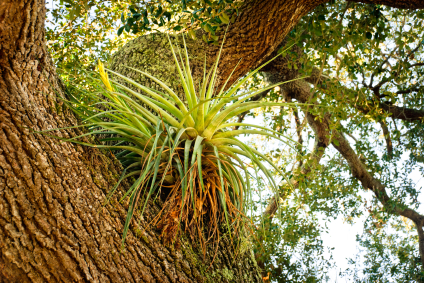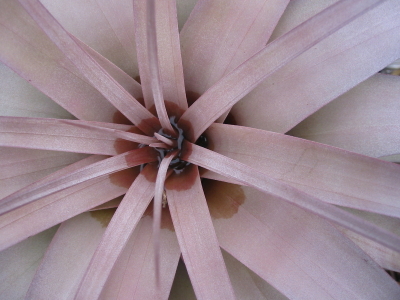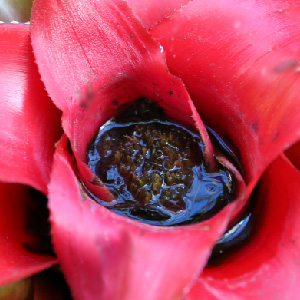Bromeliad Glossary: Learn to Talk like a Pro
Author: Melanie Dearringer2 Comments
As you are growing bromeliads, collecting new plants, and referencing resources you may come across many unfamiliar terms. Many of these terms will be helpful to add to your vocabulary as you become a bromeliad enthusiast. There are words that refer to the various parts of bromeliads, as well as the shape and form. There are also important words that deal with the care and culture of bromeliads.
This post provides definitions for the most commonly used terms among bromeliad growers. It is intended to help the beginner bromeliad grower understand the world of bromeliads.

-An Air Plant
Air Plant: A common name used for any plant that grows attached to a substrate. They are also known as epiphytes. Air Plant is often used to refer to Tillandsias, a particularly popular genus of bromeliad.
Axil: The point where two or more leaves come together at the stem. Leaf axils often form cups that take in water for a bromeliad plant. Leaf axils are also hiding places for pests and should be inspected when introducing a new bromeliad into your collection and regularly there after to prevent infestations.
Bigeneric: A cultivar created from two different genera of plants. This is accomplished by horticulturists with bromeliads in cultivation.
Bract: Modified leaves that are part of an inflorescence. They are typically colorful and often mistaken for the flowers themselves.
Common Name: The informal name used for a species of plant that is commonly accepted by growers.
Cultivar: A crafted hybrid between two or more species that does not occur in nature.
Discolor: Having leaves that are two different colors, usually one color on the top and another color on the bottom.
Epiphyte: A plant that grows on a substrate such as another tree, shrub or piece of wood or bark. An epiphyte takes in its own nutrients and water and is therefore not a parasite. It typically does not cause damage to the substrate. Spanish moss is an example of an epiphyte.
Genera: The plural of genus.
Genus: A grouping of plants that have similar characteristics. There are often many species found within a genus. This is the first name listed in scientific names, it is always capitalized.
Habit: Refers to the growth habits of plants. For example, height, width and shape of the plants.
Hybrid: A cross between two different species.
Inflorescence: The entire flowering portion of a plant. This may include bracts, spikes and flowers.
Lithophyte: A plant that grows on rocks.
Mealybugs: A common bromeliad pest. They look like cottony masses and often form colonies in leaf axils. They can be removed by swabbing with rubbing alcohol or a combination of dish soap and water.
Monocarpic: A plant that produces only one inflorescence. Most bromeliads are monocarpic.
Mother Plant: The original plant from which a pup is produced.
Offset: A shoot that results in an entirely new plant. It is connected to the mother plant, but can be removed and allowed to grow on its own. Bromeliad growers often call this a pup.

-A Pink Bromeliad Heart
Pendant: This refers to the habit of the inflorescence. The scape hangs in a drooping fashion to the side of the plant rather than standing erect.
Potting Medium: The mixture that terrestrial bromeliads should be planted in. For many bromeliads this should be a soilless mixture of bark, perlite and peat moss. Mixes specifically formulated for bromeliads can be found at garden centers and nurseries.
Propagation: The act of producing more plants from an original either through seeds, cuttings, or pups.
Pup: The new growth on a bromeliad that results in an entirely new plant. The pup is an exact copy of the original plant. Pups are also referred to as offsets.
Rachis: Tropiflora defines this as “the central spine of an inflorescence.”
Range: The area where a species grows naturally in the wild.
Root Rot: A common ailment that occurs when the potting medium remains too wet for too long. The plant’s roots will rot causing significant damage to the entire plant. To avoid root rot use a well draining potting medium and allow it to dry a bit between waterings. It is usually better to err on the side of letting a bromeliad dry out than to overwater it.
Rosette: This refers to the shape of the plant. Many bromeliad plants have leaves that grow in a tight circular fashion, creating a rose shaped form.
Saxicolous: These are plants that grow among rocks or on the sides of cliffs.
Scale: A common bromeliad pest that appears as small, brown, oval shaped spots. They can be removed by swiping with rubbing alcohol.
Scape: The tall inflorescence stalk that bears flowers. It can be branched or have bracts. It is often colorful.
Sessile: Plants without a stem or inflorescence without a scape.
Spike: “An unbranched inflorescence bearing sessile flowers,” according to Tropiflora. However, spike is often used to refer to any inflorescence that raises above the leaves of the plant.
Species: The unique classification of plants that identifies a group as similar and naturally capable of producing offspring. Every plant in a species will have the same specific characteristics. In written scientific names this is the second part of the name, it is never capitalized.
Tank: The central cup that is formed by the rosettes of the bromeliad. Many bromeliads just have one central tank, but some have tanks that form at all of the leaf axils. Many bromeliads take in water and nutrients through their tank and the tank should remain filled. It is also important to fill tanks with rain water or distilled water to prevent mineral build-up. Tanks should be flushed occasionally to prevent stagnation and disease.
Terrestrial: Plants that are terrestrial naturally grow in the ground and take up their water and nutrients through roots in the soil. Many bromeliads are epiphytes, but can be planted terrestrially in cultivation. Vriesia, and Guzmania are two examples of popular bromeliads that are epiphytic, but are often grown terrestrially.
Trichomes: Special scales found on the leaves of bromeliads. They take in water and nutrients in addition to or in place of the roots. Trichomes are especially noticeable on Tillandsias. They often produce a hairy or silvery look.
Urn: Another name for tank.
Variegated: Used to describe leaves that have one or more different colors. Variegation often appears as stripes or bands, but can be in any other pattern as well. Green and white is a common variegation color combination, but many bromeliads also offer green and burgundy, green and yellow or green and pink.
Xeric: These plants are adapted to thrive in very arid conditions. Many bromeliads prefer humid tropical conditions, but a few prefer drier climates.
These words and expressions will help navigate the world of bromeliad care. Knowing the proper terms for the parts of the plants and the descriptions of the growth habits will help you choose the plants you want. It will also help you provide the proper care for your plants once you bring them home.
Are there any terms you have come across that need clarification?
Sources
“Bromeliad Info.” Bromeliad Society International. <www.bsi.org>
“Glossary of Terms.” Tropiflora. <http://www.tropiflora.com/glossary.cfm?CFID=5469084&CFTOKEN=ad52a602a924e01b-C83FB63C-9756-DD4B-F8C6904F07BDEF3B&jsessionid=4030cf504bc82fa7a2f4745d6f2261d71247&>
“Bromeliaceae” Wikipedia. <http://en.wikipedia.org/wiki/Bromeliads>
2 Responses to “Bromeliad Glossary: Learn to Talk like a Pro”
Leave a Reply

Resource Download
Hechtia Care Cheat Sheet
Learn how to care for your Hechtia bromeliad with this quick and easy informational guide.
Learn More
Ask an Expert
Questions about bromeliads?
Our experts love a challenge!
Photo of the Week
Submit your photo to be featured on the blog!
More Photo of the Week Winners
Submit Photo









I just bought a bromeliad, and the instructions say to place water in the center of the plant. But the pot, the soil is totally dry. Should I also water the soil in the pot?
I teach about bromeliads and have been my favorite for 10 years, as for the watering, since they take up their water from the tank or the roots, it is best to choose one method as overwatering can lead to fungal infection. Usually those in the ground do well on weekly, however, in the pot it is better to check the soil and water only if dry, or use a clay item to let you know. Also since their root systems are not extensive, try to keep from getting into a large pot, more than 6 in unless it is a huge one as they do like tight roots systems. Pups need to go into small pots and monitor water until they form their rooting in about 1 month.